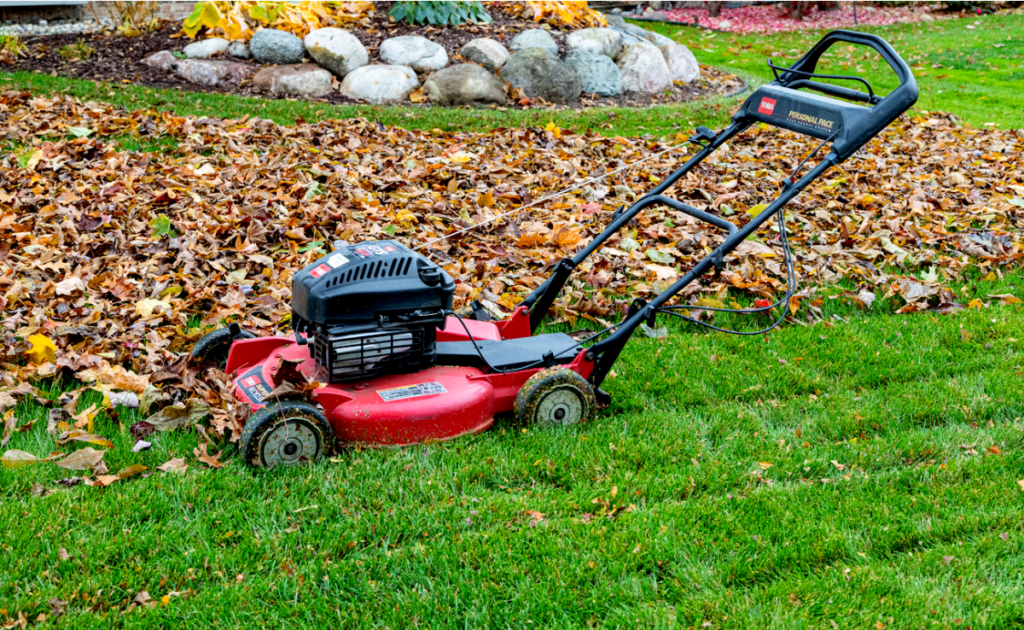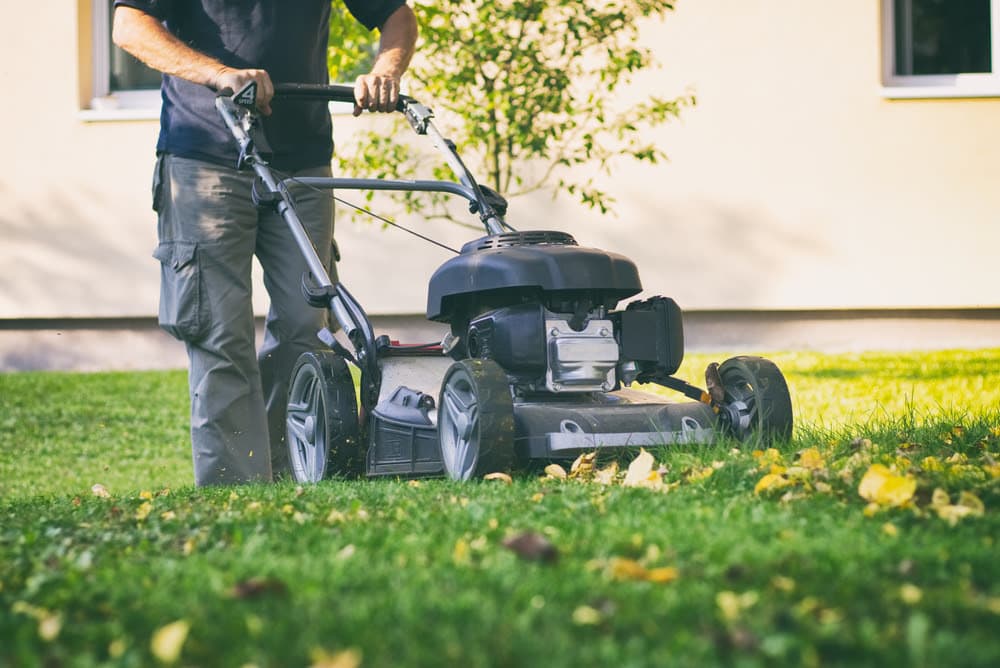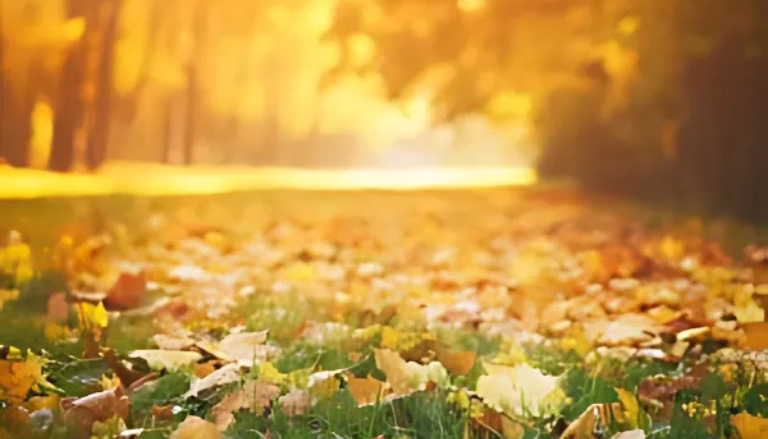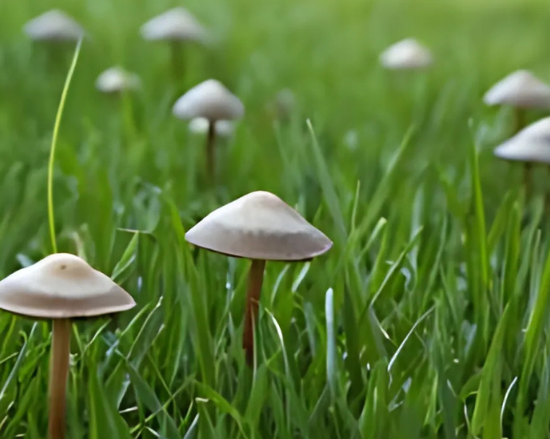Fall is the right time to be aware of the conservation of our beautiful lawn. It is the ideal time to give it the best possible care to ensure its good health. This will serve to repair the damage caused by the recurrent summer droughts and protect your lawn from the icy winter weather. So, here are a few tips from the pros to help you prepare your lawn for the winter season.

Here is the illustration of leafcycling! In this photo you can observe the efficiency of a mower equipped with a mulching blade. However, i recommend that you mow more regularly and avoid too much accumulation (as shown in this photo) in order to get a better result.
1. Pratice leafcycling
We strongly advise you to adopt this technique which offers the same benefits as grasscycling. For those who don’t know, leafcycling consists of feeding the lawn by mowing your dead leaves without the bag (mulching). They will act as a natural fertilizer.
Benefits of this technique
- Shredded leaves will restore important nutrients to your lawn. In addition, leafcycling feeds beneficial microorganisms by providing sugars, and this will increase the productivity of your soil. Finally, it will help fortify your lawn so that it can withstand the winter cold.
- Adopting leafcycling will save you time and energy: the arduous hours you won’t spend raking leaves will be used to relax at home or fully enjoy your hobbies!
- Finally, there is a significant environmental aspect. You won’t have to use a plastic bag to dispose of your mowed leaves. As we know, a plastic bag can take over five hundred years to decompose! Otherwise, you can always think of the brown composting bins recently established in Laval to combat the problem..
Tips on how to be an expert
- As with grasscycling, use a mulching blade. Make sure it is sharp enough. This type of blade will cut the leaves into smaller pieces, making it easier to break down
- Don’t wait until there are many leaves. Mow as they fall.
Important
We strongly advise against leafcycling for conifer thorns and cedar scales: they acidify the soil. When they decompose, they release acidity into the soil which will eventually harm your lawn. We recommend that you pick them up right away to avoid potential problems.
If you do not do leafcycling, we strongly recommend that you collect the leaves that end up on your lawn in the fall. The unshredded leaves will prevent the sun’s rays from reaching the foliage of your grasses (lawn). This will prevent the photosynthesis process which is essential to the survival of your lawn. It is therefore necessary to remove them if you want your lawn to be beautiful in the spring.

2. The last mowing
In order to have a beautiful lawn in the spring, we recommend that you make your last mowing slightly shorter than usual. It is important not to leave your lawn too long before winter arrives. You can adjust your mower to two or two and a half inches for your last mowing. This will help prevent many fungal diseases from developing. Also, a slightly shorter last mowing will help prevent field mice infestations. Be careful! In order to avoid potential stress, it is not recommended to mow more than 30% of the height in one go! Therefore, do your last mowing in two parts if your lawn is too long. Having a shorter lawn increases resistance to winter conditions which are very difficult in Quebec.
The last mowing should be done very late in the fall. Depending on your judgment, mow as late as possible (before the first snowfall).
Some people do their last mowing a little too early! Know that the lawn will grow as long as there is some heat!

3. Install a protective cover on your lawn
It may be advisable to install a tarp on the front of your property if you receive a lot of dirt and salt during the winter. A heavy build-up of these abrasive materials will be detrimental to your lawn’s recovery in the spring.
The fabric will help protect your lawn from this potential harmful build-up. With it, it will be very easy to remove this accumulation when spring arrives.
If you don’t normally get a lot of dirt during the winter, there is no need to invest in a protective cover. You can simply clean your yard in the spring.
The best covers to protect lawns are available at nurseries or stores as BMR, Patrick Morin, etc..
When should it be installed?
IMPORTANT
It is essential to install it as late as possible (before the first snowfall) and remove it as soon as possible at the beginning of the next season! Some people even wait for the first light snowfall before installing their protective covers.
If you do not respect these conditions to the letter and your lawn is still growing when you install your cover, or if you delay removing it in the spring, it will prevent the sun’s rays from photosynthesizing and this will inevitably cause damage. Grass is a plant that needs the sun to live.

4. Take the necessary care for winter preparation
You do not need to apply a fertilizer product before winter. We already apply the required fall fertilization on your land. On the other hand, aeration and/or lime treatment is very effective in preparing your soil for the following season.
By aerating your soil, your root system will be strengthened. This will increase its resistance to frost and prevent possible damage. Note: it is the frost at the roots that creates the damage, which is why a developed (unrestricted) root system is important.
In addition, by treating with dolomitic lime (recommended in combination with aeration), the acidification of your soil will be neutralized. This will increase the recovery of your lawn next spring and increase the effectiveness of our fertilizers the following season.

In conclusion, Le Génie en Herbe team is pleased to offer you the best possible advice on lawn care. We are passionate and dedicated to our work, and your satisfaction is our priority!
We wish you all a great winter! ⛄



